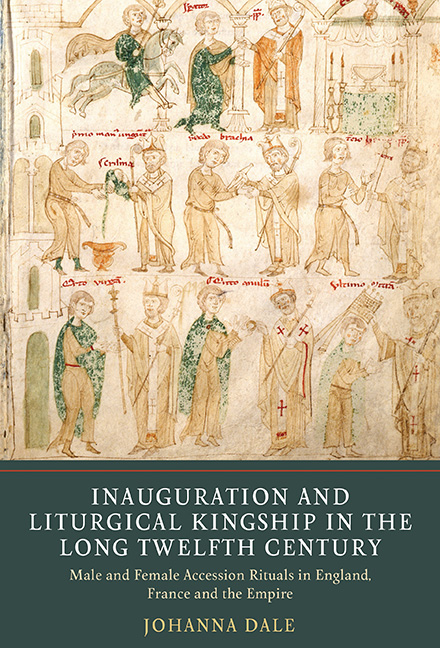 Inauguration and Liturgical Kingship in the Long Twelfth Century
Inauguration and Liturgical Kingship in the Long Twelfth Century Book contents
- Frontmatter
- Contents
- List of Illustrations
- Acknowledgements
- List of Abbreviations
- Timeline
- Genealogies
- Introduction
- 1 Liturgical Texts: The Spoken Word and Song
- 2 Liturgical Rituals: Rubrication and Regalia
- 3 Who and Where? Actors, Location and Legitimacy
- 4 What and When? Consecration and the Liturgical Calendar
- 5 Royal Titles, Anniversaries and their Meaning: The Charter Evidence
- 6 Seal Impressions and Christomimetic Kingship
- Conclusion
- Appendix 1 Editions and Manuscripts of the Selected Ordines
- Appendix 2 Prayer Formulae Incipits
- Appendix 3 Tables of Ritual Elements in the Ordines
- Appendix 4 Brief Descriptions of Royal and Imperial Seals and Bullae
- Bibliography
- Index of Biblical References
- General Index
5 - Royal Titles, Anniversaries and their Meaning: The Charter Evidence
Published online by Cambridge University Press: 25 October 2019
- Frontmatter
- Contents
- List of Illustrations
- Acknowledgements
- List of Abbreviations
- Timeline
- Genealogies
- Introduction
- 1 Liturgical Texts: The Spoken Word and Song
- 2 Liturgical Rituals: Rubrication and Regalia
- 3 Who and Where? Actors, Location and Legitimacy
- 4 What and When? Consecration and the Liturgical Calendar
- 5 Royal Titles, Anniversaries and their Meaning: The Charter Evidence
- 6 Seal Impressions and Christomimetic Kingship
- Conclusion
- Appendix 1 Editions and Manuscripts of the Selected Ordines
- Appendix 2 Prayer Formulae Incipits
- Appendix 3 Tables of Ritual Elements in the Ordines
- Appendix 4 Brief Descriptions of Royal and Imperial Seals and Bullae
- Bibliography
- Index of Biblical References
- General Index
Summary
Henry of Huntingdon tells us that ‘in the year 1100, in the thirteenth year of his reign, King William [II of England] ended his cruel life in a wretched death’. Henry goes on to describe Rufus's many shortcomings as king, concluding that ‘whatever was displeasing to God and to those who loved God was pleasing to this king and those who loved him. Nor did they exercise their unspeakable debauchery in secret, but unashamedly in the light of day. He was buried at Winchester on the day after his perdition.’ Within days of Rufus's death, his younger brother Henry was consecrated king at Westminster Abbey, on the following Sunday, which as we have seen was the feast of St Oswald, king and martyr. In the absence of the exiled archbishop of Canterbury, the bishop of London officiated, but only after Henry I had ‘promised a wished-for amendment of laws and customs’. This ‘wished-for amendment’ is better known as the ‘coronation charter’ of Henry I, perhaps the most famous non-liturgical document associated with royal consecration in the central Middle Ages. This being the case, it is striking that no original survives, although there are many manuscript copies from the later twelfth and thirteenth centuries. Henry's coronation charter was a swiftly negotiated agreement to ensure his consecration, necessary due to his brother Robert Curthose's claim to the throne, and the perceived iniquity of his predecessor Rufus. Many of its clauses claim specifically to remedy wrongs committed by Rufus, as is acknowledged in the charter itself. Due to its later importance as a source used by the barons in the composition of Magna Carta in 1215, it has often been discussed in the context of legal and constitutional history. As with so many English administrative documents, it has become a legal exemplar, hermetically separated from the liturgical context in which it was originally granted. However, while challenging traditional legal-historical approaches to Henry's ‘coronation’ charter, it is apparent that the focus of this earlier scholarship rightly reflects the importance of the issuance of documents to royal and imperial consecration. Moreover, as shall be demonstrated, the manner in which royal documents were authenticated frequently referred back to the ceremony in which the king had been made monarch.
- Type
- Chapter
- Information
- Inauguration and Liturgical Kingship in the Long Twelfth CenturyMale and Female Accession Rituals in England, France and the Empire, pp. 159 - 190Publisher: Boydell & BrewerPrint publication year: 2019


